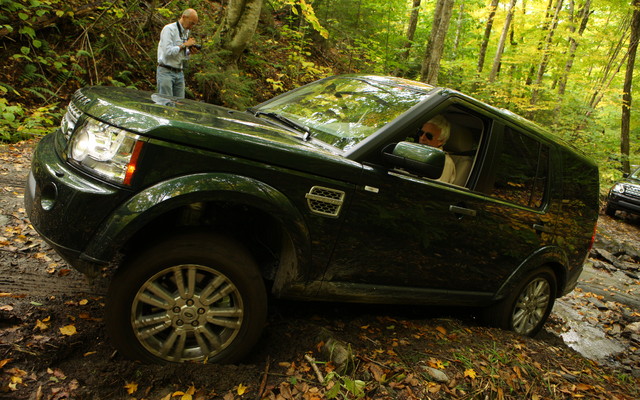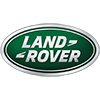2010 Land Rover: Dragged through the mud and loving every minute of it!
Easily the most British of all British brands, Land Rover is trying to weather the storm. Indeed, most high end manufacturers have suffered through some hard times these last several months, and it’s a safe bet that there’s more to come. When hundreds of workers are laid off by a company, it isn’t easy for its president to justify upgrading his 2007 Range Rover to the 2010 model...
In these unique circumstances, Land Rover, which makes barely 100,000 vehicles per year, has to find a way to set itself apart while remaining true to a tradition that fans of the brand are not ready to give up. But more importantly, Land Rover has to find a way to survive while continuing to manufacture vehicles that guzzle fuel like a 747!
In an attempt to partially offset the gas consumption of its enormous 4x4s, Land Rover is pulling a few aces out of its sleeve. First off, beginning next year, the British firm, which now belongs to the Indian company Tata after several years under the Ford umbrella, will unveil a small 4x4 called the LRX. At a recent conference, the Land Rover brain trust said that this new vehicle, presented at the 2008 Detroit Auto Show under the name LRX Cross Coupe Concept, will be in production starting in 2011. It’s the first Land Rover coupe.
Barely a week ago, The Car Guide had the chance to go to Manchester, Vermont, for the presentation of the 2010 models of the Land Rover LR4, Range Rover and Range Rover Sport. Unfortunately, the LR2 compact SUV was not invited. Was it because there wasn’t enough time to test it? Were there logistical problems? Land Rover just didn’t want to? ...Perhaps it was simply because it’s unchanged this year. We’ll have to wait and see...
LR4
According to Land Rover, owners of the old LR3 (produced until last year) considered it too rough, as much in terms of its exterior lines as for the lines of the dashboard. Its replacement, the LR4, features lines that are less boxy and it has a razor grille like the other Land Rover models. What’s more, the dashboard was transformed for the better. However, as near as we can tell, the LR4 is nothing more than a more modern LR3.
The biggest change is under the hood. Gone is the ill-adapted 4.0-litre V6 and the V8 goes from 4.4 litres to 5.0 litres. It features 375 hp and an equivalent torque. Land Rover says it goes from 0-100 km/hr in 7.9 seconds, which seems realistic. Moreover, this engine is said to be more fuel efficient than the 4.4 it’s replacing. All right, but we aren’t talking about a major savings here. Like all the modern and powerful engines that have to propel a lot of weight (2,646 kilos in this case), it’s quite frugal on the open road at a regular speed with the wind at its back. But the slightest sudden acceleration will make the gas evaporate like water in a kettle. This box on wheels can tow up to 3,500 kilos (7,716 pounds) if the trailer comes equipped with brakes.
While the LR4 is much smaller than the Range Rover and Range Rover Sport, its passenger compartment turns out to be very, very comfortable just the same. The large windows combined with the large exterior rearview mirrors ensure good overall visibility. Although the second row seats are very good, the same cannot be said for the third row, which is hard to access. They’re tough to handle and you’ll be more inclined to swear at them than sit in them.
Land Rover products always feature excellent handling but these vehicles, and the LR4 is no exception, truly stand out off road. In the middle of the dash there a big button that controls a system called “Terrain Response”. All the driver has to do is choose between certain modes (general driving, snow, mud and ruts, sand and rock crawl) and the vehicle does almost everything else! This system is mainly controlled by the ABS brakes and the lateral stability system and takes several engine, transmission and differential settings into consideration. The “Hill Descent Control”, which helps the vehicle descend difficult slopes at a steady speed almost without human intervention compliments the Terrain Response system. As soon as you select “low mode”, the suspensions raise to increase ground clearance (it goes from 185 mm to 240 mm). The LR4 is the most high performance of the Land Rover products for off road use with its approach (37.2 degrees), departure (29.6 degrees) and breakover (27.9 degrees) angles (these numbers are valid when the suspensions are at their maximum height). Basically, the only way you’ll get stuck in an LR4 is if you’re driving through a tsunami or on a planet that has never been explored by humans!
Range Rover
If the Range Rover, a high end 4x4 if there ever was one, has hardly changed at all, it’s because its clients didn’t want them to change a thing! So, the headlights, the grille and the taillights were revised but you have to have a keen eye to spot the differences at first glance. However, the whole electrical system is new, which is good news considering Land Rover products’ horrible reputation for reliability...
The factory standard engine is the same as that of the LR4, that is a 5.0-litre, 375-hp V8. Although it’s longer than the LR4 and it seems heavier, the Range Rover gives up a few millimetres here and there and more importantly, 62 kilos. Note that the passenger compartment is so soft and comfortable that the few tenths of a second more that it needs to go from 0-100 km/hr aren’t even noticeable, but you can tell that it has all the power it needs!
If the regular version’s 375 horsepower is sufficient, why pay another $18,000 ($93,830 instead of $111,900) for the Supercharged’s 510 horses? What’s more, it doesn’t have even an ounce more towing capacity. Be that as it may, this muscle-bound monster will let you go anywhere, any time. It’s the perfect vehicle for people who have to get some place fast!
Supercharged or not, luxury and comfort reign supreme. However, getting in and out of the vehicle is not exactly easy thanks to its height. Running-boards would be a welcome addition but they would break the most basic rules of off-road etiquette.
As noted at the launch of the vehicle, the Land Rover, this palace on wheels, is able to take on most any road conditions. Sure, on an extremely difficult trail, sometimes it has to let the LR4 go by, but to get to that point, you have to have a very thorough knowledge of 4x4s. Our test vehicle even had five cameras that showed what was going on around the vehicle. There are two under the front bumper, one on each exterior rear-view mirror and a rear-view backup camera. On difficult trails if you don’t have a spotter to direct you, these cameras will save you a tonne of headaches. As you’d expect, there aren’t many people who would put a $90,000 car in the mud (and few $30,000 SUV owners would go in the mud either) but, according to Land Rover, many owners of older Land Rovers have no qualms about exploring uncharted territory with their vehicle.
Range Rover Sport
The Range Rover Sport (RRS to its friends) has undergone a few more changes than the Range Rover. It isn’t very noticeable on the outside, but the dashboard has been completely revised.
Although its lines scream pure Land Rover, the Range Rover Sport is a bit of an anachronism compared to other models. In this case, the word “sport” is not just window dressing. After only a few metres, the firmer suspensions, the much livelier steering and weight transfers that are much less pronounced than those of the regular Range Rover are immediately noticeable. Strangely, while it has a much sportier personality, the Range Rover Sport has the same engines and the same horsepower, notably a 5.0 litre V8 featuring 375 horses and 510 horses in the Supercharged version. You’ll be happy if you’re into a sporty ride, but I’d be curious to put an RRS up against a Porsche Cayenne on a track…
While it holds its own when the roads turns rough, the Range Rover Sport remains the least capable of all the Land Rovers, LR2 notwithstanding. But who would want to blow a 275/40R20 (Supercharged) tire on a sharp rock? By the way, during the launch, we didn’t test this vehicle off road.
And although the Range Rover Sport is more dynamic than the other members of the Land Rover royal family, like the others, there’s no change in comfort, material quality or quality of finish.
What about reliability?
Over the course of the two-day launch, the nice people at Land Rover were available to answer all questions to the best of their considerable knowledge. However, the elephant in the room was reliability… To the extent that in the time between the end of the question and the beginning of the response I had enough time to take apart and rebuild a transmission (not that I have ever done that before)... I don’t remember the exact words of the folks at Land Rover, but to summarize: “No, Land Rover isn’t very reliable but we are working hard to improve our vehicles. And rest assured that Land Rover will never turn its back on an owner.” We hope, for the sake of Land Rover and Land Rover owners that the overall reliability improves, since, according to J.D. Power, it’s ranked 35th out of 37 brands in terms of reliability...












